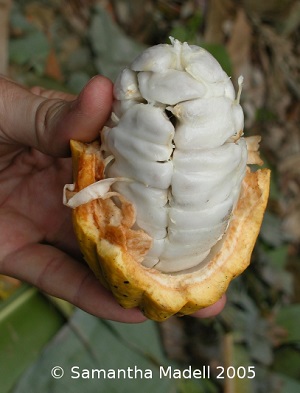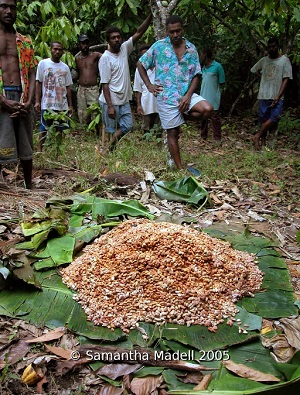The science of cacao fermentation 1: what happens during cacao fermentation?
Prior to being dried, cacao seeds (or “cocoa beans”)
are fermented … or, more accurately, the fruity white pulp which
envelops the beans is fermented.

Freshly harvested cocoa pod
Cacao
fermentation doesn’t technically ferment the beans – it
actually ferments the fruity white pulp which encases the beans.
The
fermentation process liquifies the pulp, allowing it to drain away.
This reduction in pulp assists the drying process. But most
importantly, cocoa fermentation triggers an array of chemical changes
within the bean. These chemical changes are vital to the development of
the complex and much-loved flavour known as “chocolate”.
Prior
to fermentation, the ripe cacao fruits (known as pods) are carefully
cut from the tree. The harvested pods are taken to a central location,
where the fermentation will take place. Some growers ferment their own
beans in relatively small heaps on the earth floor of the plantation,
while others take their pods to a co-op for larger-scale box
fermentation. But regardless of the scale of the operation, the
fermentation process is essentially the same.
When the pods have been gathered at the fermentary, they are broken open, and the beans are scooped out.
a heap of fermenting cacao on the forest floor

The men of Olboe village in Vanuatu, standing around a heap of cocoa beans
which are fermenting on the forest floor
After the beans are turned, they are re-covered with banana leaves, which helps the heap to ferment evenly.
a three-bay box for fermenting cacao beans

An alternative method of fermenting cocoa beans:
a three-bay cacao fermentation box on Malo island, Vanuatu
For
as long as a cacao pod remains intact, its interior is sterile, meaning
that it contains no yeasts or bacteria. However, during the
pod-breaking and bean-scooping stage, the pulp is inoculated with wild
yeasts and bacteria. Scientists have found that the bulk of these
microogranisms are generally transferred from the skins of the pods to
the beans, via the bean-scoopers’ hands.
In the first
stage of fermentation, the wild yeasts rapidly multiply in the sweet,
fruity pulp, converting the pulp’s sugar into alcohol. This
initial phase takes place in the absence of oxygen – hence, it is
known as anaerobic fermentation. The yeast population peaks within 24
hours.
After the yeasts have done their work, bacteria begin to
take over the fermentation process, converting the alcohol into acid.
This acid slowly penetrates the bean.
The bacterial phase of fermentation takes place in the presence of
oxygen – hence, it is known as aerobic fermentation. This phase
requires a significant amount of oxygen, so the beans are typically
turned at least twice during the fermentation process, in order to
introduce oxygen into the heap, and to ensure that all of the beans are
fermented evenly. Typically, the beans are turned at about 48 and 72
hours after fermentation begins.
The bacteria population peaks
roughly 72 hours after fermentation first begins, and decreases rapidly
over the following 72 hours. Hence, the entire fermentation process
typically takes about 144 hours (six days).
As well as producing
alcohol and acid, the fermentation process also generates heat,
typically raising the temperature of the fermenting beans to about 45
to 50 degrees Celsius (113 to 122 Fahrenheit).
Phase 1 (anaerobic): sugar + yeast –> alcohol + carbon dioxide + heatPhase 2 (aerobic): alcohol + bacteria + oxygen –> acid + water + heatThe
acid and heat generated by the fermentation kills the cocoa bean. In
turn, the bean’s death causes cell walls within the bean to break down,
allowing enzymes to come into contact with their substrates. These
enzymes bring about some very important chemical changes within the
bean, some of which are listed under points 2 and 3, below.
Enzyme:
a protein that induces chemical changes in other substances. The
substance that an enzyme changes is known generically as a substrate.=======
Very broadly speaking, three major changes happen inside the cocoa bean during fermentation:
1. Acid penetrates the bean. The acid kills the bean, lowers its pH, and produces a sour, acidic taste.
2.
Bitter and astringent flavonoids are converted into milder-tasting
substances. (These enzymatic processes also turn the bean from a white
or purple colour, to chocolate brown.)
3. Aroma precursors are produced. These aroma precursors are later transformed into aromas, during roasting.
Below I explain these three major changes in more detail:
1. Acid penetrates the bean.As
previously mentioned, some of the acid which is produced by bacteria
during the second phase of fermentation penetrates the bean. This acid
is primarily acetic acid: the same acid that gives vinegar its sour
taste. Most of this acid is later evaporated out of the bean, during
drying and conching. However, a moderate amount of residual acidity can
lend a desirable, fruity complexity to cocoa.
2. Bitter and astringent flavonoids are converted into milder-tasting substances.Freshly
harvested cocoa beans are extremely bitter, astringent, and
unpalatable. This unpleasant bitterness is primarily due to high levels
of water-soluble flavonoids (a.k.a antioxidants) in the bean. During
fermentation, these flavonoids undergo a complex series of chemical
transformations. For example:
* Some flavonoids combine with
other flavonoids to produce larger molecules known as condensed
tannins, or proanthocyanidins. This process is very similar to the
mellowing process that fine red wine undergoes as it ages.
Incidentally, proanthocyanidins are a category of antioxidants that are
widely believed to be very good for you (this is why the media often
hypes chocolate as a “health food”).
* In a
multi-step process, some flavonoids oxidise and condense, producing the
classic chocolate brown pigmentation in cocoa. This process is known
generically as enzymatic browning.
During cocoa fermentation,
flavonoids combine with eachother, and with proteins and amino acids,
in myriad ways – not all of which are perfectly understood by
science. For example:
anthocyanin [purple] + glucosidase enzymes -> anthocyanidin [purple] + sugar
anthocyanidin [purple] + polyphenol oxidase enzymes + oxygen -> quinone [yellow]
quinones [yellow] + other flavonoids + amino acids -> condensed tannins
condensed tannins + proteins -> melanin [brown, water insoluble pigment]
3. Aroma precursor development.Freshly
harvested cocoa beans taste nothing like chocolate. The bulk of the
chocolate flavour-production happens during roasting, when a type of
chemical reaction known as the Maillard reaction takes place. (The
Maillard reaction is often confused with caramelization, which is the
browning of sugar. For example, in his book, “Discover
Chocolate”, Clay Gordon incorrectly states that cocoa beans are
“caramelized during roasting” (p70).)
The Maillard
reaction is a reaction between so-called “aroma precursors”
– namely, amino acids and reducing sugars. When cocoa is roasted,
the aroma precursors combine in different ways to create dozens of
different flavor compounds.
These all-important aroma precursors are produced during fermentation as a result of enzyme activity. For example:
* Protease enzymes break proteins down into peptides and amino acids.
*
Invertase enzymes break sucrose down into fructose and glucose.
Fructose and glucose are known as “reducing sugars”
=====
After
fermentation, the cocoa beans are dried. Drying reduces the moisture
content in the bean from about 55% to about 7%. With a moisture content
of 7%, cocoa beans can keep for many years (in ideal storage
conditions).
=====
Notes regarding the colour of cocoa beans:


